
Carlisle Transfer
The passenger and goods facilities around Carlisle were worlds apart in their levels of efficiency. The spacious, jointly owned Citadel Station concentrated all the passenger trains at the one location for easy interchange between the services of the seven English and Scottish companies that operated to Carlisle before the 1923 Grouping.
No attempt was made by the same seven companies to centralise the goods services, as a result the town was ringed with yards and goods depots. Transfer freights between all these facilities caused a great deal of congestion with up to 40 locomotives dedicated to local trip workings and yard shunting. The goods lines avoiding Citadel Station were essential to prevent delays to the passenger services. This fragmented state of affairs lasted until 1963 when a huge marshalling yard at Kingmoor, to the north of the city was opened. It greatly improved the speed of freight through Carlisle and saved a fortune in enginemen's wages, but it came too late.
This 1 hour session looks at just one of those dozens of transfer goods trains that were such a common sight of the railway scene of Carlisle, this one travels from Durran Hill to Currock Junction Sidings and returns via Upperby Yard.
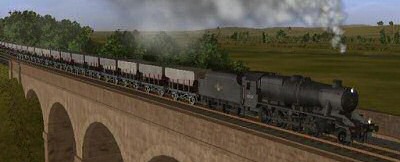
Anhydrite for Marchon
The Long Meg to Widnes anhydrite trains were a common sight on the S&C. A less frequent service from Long Meg was to the Marchon sulphuric acid works at Whitehaven, a train which travelled via Carlisle.
This 50 minute session starts at Durran Hill mpd and finishes at Currock Junction.
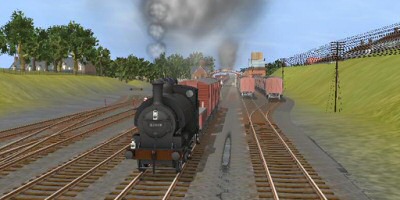
Appleby Shunting
Most railway enthusiasts gravitate towards the glamour of the express trains, some also accommodate the main line goods trains. But the majority of locomotives employed in Britain were used for the very mundane tasks of shunting and short trip work between sidings.
This session follows one such shunting turn, completing three jobs in the small yard at Appleby. This session will last about 40 minutes.
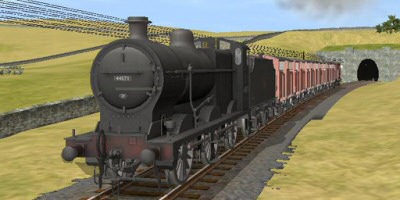
Cattle for Hawes
There weren't many sources of goods traffic for the S&C. The lime kilns and granite quarries of Ribblesdale and the anhydrite mine at Long Meg were the only regular sources of traffic. Livestock transfer was an occasional demand, to and from the major markets at Settle, Hawes and Appleby.
This session follows on from cattle loading in the Appleby Shunting session. The cattle trucks are waiting for distribution as far south as Hawes. What better locomotive to complete this job than a trusty 4F 0-6-0? The session will take just over 1 hour to complete.
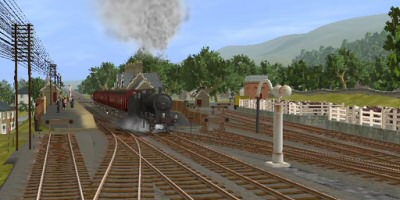
Morning Commuter
The south end of the Settle and Carlisle line had some commuter traffic. There were morning trains into the industrial towns of Lancashire and Yorkshire from Skipton and Hellifield and a business man's express from Morecambe into West Yorkshire.
In the evening there were corresponding return services.
This session focuses on the morning Settle to Bradford stopping train which transported those people who worked in a large city but were fortunate enough to be able to live in the countryside or villages of Craven. The session follows the train as far as Skipton and takes 45 minutes
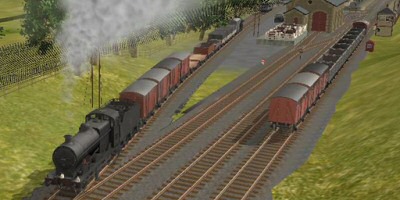
NWR Pickup
The daily pickup goods was a feature of many railway routes up to the 1960s. These trains pottered from station to station shunting the yards, collecting and delivering a wide variety of vans and wagons. This had been going on for over 100 years whilst the railways carried all the merchandise as well as the passenger traffic. By 1960 with road competition the pickup goods was hopelessly uneconomic and faded away within 10 years.
This session follows part of the route of one such pickup goods travelling from Skipton to Lancaster. It will take about 90 minutes to complete.
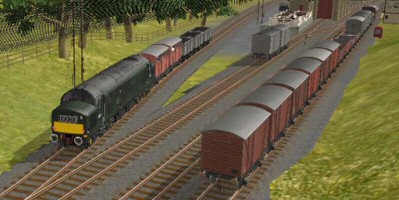
NWR Pickup Diesel
The daily pickup goods was a feature of many railway routes up to the 1960s. These trains pottered from station to station shunting the yards, collecting and delivering a wide variety of vans and wagons. This had been going on for over 100 years whilst the railways carried all the merchandise as well as the passenger traffic. By 1960 with road competition the pickup goods was hopelessly uneconomic and faded away within 10 years.
This session subsitutes a class 37 diesel for the 4F in the session above. It will take about 90 minutes to complete.
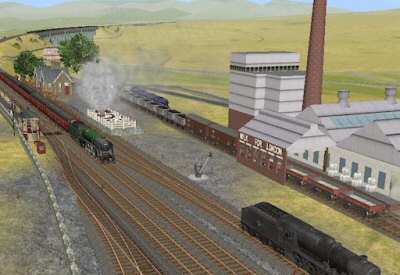
Hellifield Pickup
The ‘Ribblesdale’ route covers the section of the Settle & Carlisle Railway from Blea Moor to Settle. In order to demonstrate the operation of some new and improved interactive industries included in the TS2009: S&C package, liberties have been taken with historic reality to concentrate these industries over this section of line
Having started from Carlisle many hours before dawn, the Hellifield pickup plods mid-morning into Blea Moor up refuge loop to take water and allow an express to pass. Ahead are 2.5 hours of shunting Ribblehead yard and making quicker drop-offs or pickups at Horton, Helwith Bridge, Stainforth Sidings and Settle. These latter locations have the drop-offs unloaded and the pick-ups loaded by local ‘Jinty’ shunters.
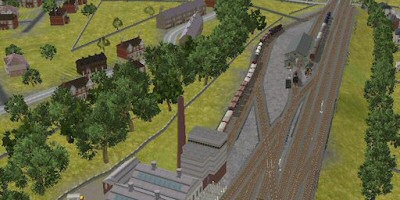
Settle Shunt
In the late 1950s and early 60s Settle’s rail facilities actually comprised a station, a goods shed and cattle docks. With the addition of an abattoir in the yard, a cheese and butter factory on the town outskirts and a plasterboard manufacturer at nearby Stainforth Sidings, we can justify the permanent loan of a ‘Jinty’ from Hellifield MPD.
The passing of the Hellifield pickup at Settle generates a lot of work for the local shunter. A string of wagons has been dropped off that are required by four industries.
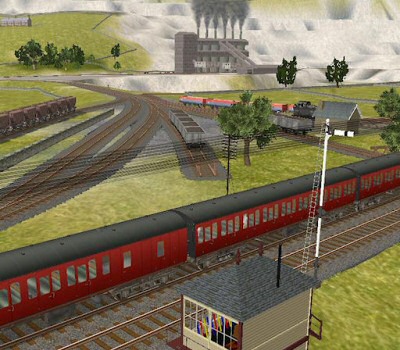
Helwith Bridge shunt
The coal-fired kilns at the Helwith Bridge limestone quarry and works were silent by 1960, but here they are revived to belch black smoke skywards. The kilns burn limestone to produce lime powder, seen in this session loaded into hoppers for distribution to chemical, cement and fertilizer plants.
Not all crushed limestone goes to the kilns – some is sent direct to customers with their own kilns or furnaces. Just up the way, accessible only from the down main line, is Dry Rigg granite quarry and loader. The rock face is shaved using explosives. The bigger chunks are drilled and split to fit in a mechanical crusher. The output of the crusher goes to bins elevated over the railway sidings.
For loads headed south, the Helwith Bridge shunter has to travel with wagon empties in the wrong direction along the down mainline to bring the loaded wagons back to Helwith Bridge sidings that are accessible by up trains like the Hellifield pickup.

10:18 Carlisle Skipton
There were a number of passenger trains that ran in the northern and southern sections of the Skipton to Carlisle route. However the population of the central section through the Pennines could not support a frequent passenger service. There were only three through passenger trains each way daily.
You will be driving a 4F 0-6-0 on the late morning train southward, all stations from Carlisle to Skipton. This is a long session, to traverse the complete route the schedule allows 3 hours. You should be able to keep up with this schedule quite easily but the session will still be a long one at well over 2 hours.
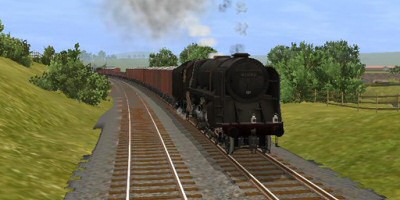
Class C Goods
Most goods trains ran at night, including the fast fitted, Class C freights, which ran between the large goods sheds of the major cities. However, there were a couple of northbound Class C that ran over the S&C in daylight.
We will follow one of these, the Leeds (Hunslet) to Carlisle, due through Skipton just before 9 am. The session will take over 2 hours.
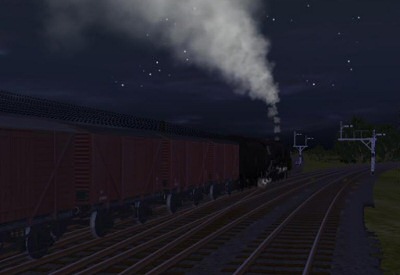
Condor (Steam)
'The Condor' was an overnight container service between London and Glasgow introduced in the late 1950s guaranteeing an early next day delivery. It was diesel hauled from the outset and ran at the fastest speeds allowed at the time for fitted brake goods stock. The up service from Scotland passed through Carlisle just before 10 pm.
This service was normally powered by a pair of Type 2 MetroVick Co-Bo locomotives. Tonight a BR 9F 2-10-0 is substituting because of failure of one of the diesels. You will start on the goods lines which by passed Carlisle Citadel Station, and then you will travel the full length of the line through Skipton.
By the 1960s The Settle and Carlisle line was fairly quiet during the day, but it came alive at night with a series of long distance goods trains climbing to Ais Gill summit. This session will last two hours.
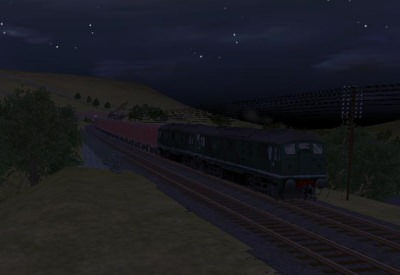
Condor (Diesel)
'The Condor' was an overnight container service between London and Glasgow introduced in the late 1950s guaranteeing an early next day delivery. It was diesel hauled from the outset and ran at the fastest speeds allowed at the time for fitted brake goods stock. The up service from Scotland passed through Carlisle just before 10 pm.
This session features a pair of Class 24 diesel locomotives rather than the pair of Type 2 MetroVick Co-Bo locomotives that were the usual motive power. You will start on the goods lines which by passed Carlisle Citadel Station, and then you will travel the full length of the line through Skipton.
By the 1960s The Settle and Carlisle line was fairly quiet during the day, but it came alive at night with a series of long distance goods trains climbing to Ais Gill summit. This session will last two hours.
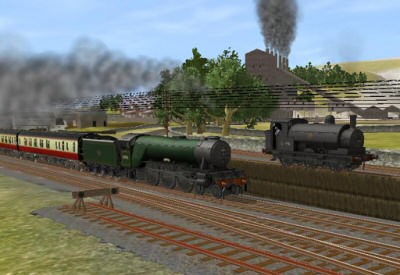
Thames Clyde Express
The 'Thames-Clyde Express' was the premier express for more than 50 years over the ex-Midland Railway lines northward from London. Up to its demise in 1975 it offered a daily service to and from Glasgow via Leeds. Not as fast as Anglo-Scottish services on the other two trunk lines, but some people chose it just for the scenery.
The train was actually non stop between Leeds and Carlisle so reality is ignored with the session starting with a stop at Skipton. The locomotive is an A3 4-6-2, some of this class operated on the S&C for a brief period just before the diesels took over from steam on express passenger services. You can choose the driver control method, the session lasts about 1 hour and 40 minutes.
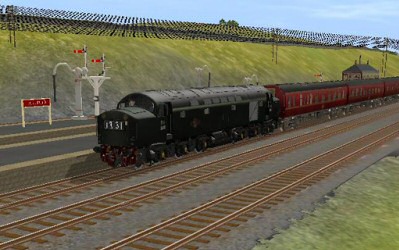
Thames Clyde Diesel
The 'Thames-Clyde Express' was the premier express for more than 50 years over the ex-Midland Railway lines northward from London. Up to its demise in 1975 it offered a daily service to and from Glasgow via Leeds. Not as fast as Anglo-Scottish services on the other two trunk lines, but some people chose it just for the scenery.
The train was actually non stop between Leeds and Carlisle so reality is ignored with the session starting with a stop at Skipton. The locomotive is a Class 40 diesel. The session lasts about 1 hour and 40 minutes.
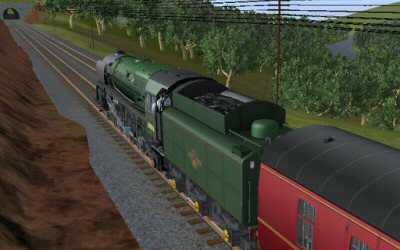
Thames Clyde Late
The 'Thames-Clyde Express' was the premier express for more than 50 years over the ex-Midland Railway lines northward from London. Up to its demise in 1975 it offered a daily service to and from Glasgow via Leeds. Not as fast as Anglo-Scottish services on the other two trunk lines, but some people chose it just for the scenery.
The train was actually non stop between Leeds and Carlisle so reality is ignored with the session starting with a stop at Skipton. This session is cab control only and lasts about 1 hour and 40 minutes. The train is running 20 minutes late and you have the opportunity of regaining time by Carlisle Citadel.